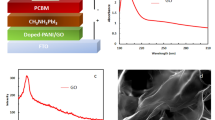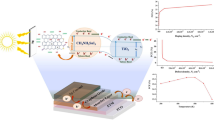Abstract
The structural and optoelectronic properties of graphene oxide (GO) bulk material were studied, and conductance and transmittance of GO thin films in absence and presence of AuNPs were optimized for further applications. GO with 0.25 mg/mL and AuNPs (0.5 mL) on GO thin films (0.25 mg/mL) were observed to have highest transmittance of 75% and 72%, respectively, and highest conductance of 7.9 × 103 S and 8.2 × 103 S, respectively. Further, these thin films were utilized as a hole transport layer (HTL) for a prototype inverted perovskite solar cell structure. GO and AuNPs/GO deposited on FTO glass show efficiency of 1.35% and 1.25%, respectively. This decrease in efficiency is associated with the deteriorated crystalline structure of perovskite in the presence of AuNPs and similar HOMO level of AuNPs as of GO, which competes hole transfer.












Similar content being viewed by others
References
Agresti A et al (2016) Efficiency and stability enhancement in perovskite solar cells by inserting lithium-neutralized graphene oxide as electron transporting layer. Adv Func Mater 26(16):2686–2694
Bhosale SS et al (2018) Functionalization of graphene oxide films with Au and MoOx nanoparticles as efficient p-contact electrodes for inverted planar perovskite solar cells. Adv Func Mater 28(37):1803200
Chaiyakun S et al (2012) Preparation and characterization of graphene oxide nanosheets. Procedia Eng 32:759–764
Chen X et al (2013) Insight into the efficiency enhancement of polymer solar cells by incorporating gold nanoparticles. Sol Energy Mater Sol Cells 111:1–8
Chou J-C et al (2015) Effect of different graphene oxide contents on dye-sensitized solar cells. IEEE J Photovolt 5(4):1106–1112
Chung C-C et al (2017) Inverted planar solar cells based on perovskite/graphene oxide hybrid composites. J Mater Chem A 5(27):13957–13965
Down MP et al (2018) Fabrication of graphene oxide supercapacitor devices. ACS Appl Energy Mater 1(2):707–714
Edri E et al (2014) Elucidating the charge carrier separation and working mechanism of CH3NH3PbI3 − xClx perovskite solar cells. Nat Commun 5:3461
Green MA, Ho-Baillie A, Snaith HJ (2014) The emergence of perovskite solar cells. Nat Photonics 8:506
Haiss W et al (2007) Determination of size and concentration of gold nanoparticles from UV–Vis spectra. Anal Chem 79(11):4215–4221
Islam K et al (2014) Effect of gold nanoparticles size on light scattering for thin film amorphous-silicon solar cells. Sol Energy 103:263–268
Jeong HY et al (2010) Graphene oxide thin films for flexible nonvolatile memory applications. Nano Lett 10(11):4381–4386
Kimling J et al (2006) Turkevich method for gold nanoparticle synthesis revisited. J Phys Chem B 110(32):15700–15707
Kogo A, Sakai N, Tatsuma T (2012) Photoelectrochemical analysis of size-dependent electronic structures of gold clusters supported on TiO2. Nanoscale 4(14):4217–4221
Konios D et al (2016) Highly efficient organic photovoltaic devices utilizing work-function tuned graphene oxide derivatives as the anode and cathode charge extraction layers. J Mater Chem A 4(5):1612–1623
Kymakis E, Konios D (2018) Graphene oxide-like materials in organic and perovskite solar cells. In: The future of semiconductor oxides in next-generation solar cells. Elsevier, Amsterdam, pp 357–394
Lee H et al (2016a) Friction and conductance imaging of sp2- and sp3-hybridized subdomains on single-layer graphene oxide. Nanoscale 8(7):4063–4069
Lee D-Y, Na S-I, Kim S-S (2016b) Graphene oxide/PEDOT:PSS composite hole transport layer for efficient and stable planar heterojunction perovskite solar cells. Nanoscale 8(3):1513–1522
Li S-S et al (2010) Solution-processable graphene oxide as an efficient hole transport layer in polymer solar cells. ACS Nano 4(6):3169–3174
Li X et al (2014) Broadband saturable absorption of graphene oxide thin film and its application in pulsed fiber lasers. IEEE J Sel Top Quantum Electron 20(5):441–447
Liu J et al (2012) Hole and electron extraction layers based on graphene oxide derivatives for high-performance bulk heterojunction solar cells. Adv Mater 24(17):2228–2233
Liu Q, Leng C, Yuan J (2018) A planar heterojunction perovskite solar cell modified by graphene oxide. In: IOP conference series: materials science and engineering. IOP Publishing, Bristol
Lu L et al (2013) Cooperative plasmonic effect of Ag and Au nanoparticles on enhancing performance of polymer solar cells. Nano Lett 13(1):59–64
Luo H et al (2017) Efficient and air-stable planar perovskite solar cells formed on graphene-oxide-modified PEDOT: PSS hole transport layer. Nano-Micro Lett 9(4):39
Marcano DC et al (2010) Improved synthesis of graphene oxide. ACS Nano 4(8):4806–4814
Murray IP et al (2011) Graphene oxide interlayers for robust, high-efficiency organic photovoltaics. J Phys Chem Lett 2(24):3006–3012
Najafi M et al (2018) Highly efficient and stable flexible perovskite solar cells with metal oxides nanoparticle charge extraction layers. Small 14(12):1702775
Nouri E, Mohammadi MR, Lianos P (2017) Inverted perovskite solar cells based on lithium-functionalized graphene oxide as an electron-transporting layer. Chem Commun 53(10):1630–1633
Patterson AL (1939) The Scherrer formula for X-ray particle size determination. Phys Rev 56(10):978–982
Pluchery O (2016) Gold nanoparticles with molecules make new electronic properties arise. http://www.insp.jussieu.fr/Gold-nanoparticles-with-molecules.html. Accessed 5 Aug 2019
Roy S et al (2011) Graphene oxide for electrochemical sensing applications. J Mater Chem 21(38):14725–14731
Shaikh AJ et al (2018) Plasmonic effects, size and biological activity relationship of Au-Ag alloy nanoparticles. J Nano Res 54:98–111
Verma S, Dutta RK (2015) A facile method of synthesizing ammonia modified graphene oxide for efficient removal of uranyl ions from aqueous medium. RSC Adv 5(94):77192–77203
Wu Z et al (2014) Efficient planar heterojunction perovskite solar cells employing graphene oxide as hole conductor. Nanoscale 6(18):10505–10510
Yu JC et al (2018) Highly efficient and stable inverted perovskite solar cell employing PEDOT: GO composite layer as a hole transport layer. Sci Rep 8(1):1070
Zhao J et al (2010) Efficient preparation of large-area graphene oxide sheets for transparent conductive films. ACS Nano 4(9):5245–5252
Zhang C et al (2017) Efficient perovskite solar cells by combination use of Au nanoparticles and insulating metal oxide. Nanoscale 9(8):2852–2864
Zhang X et al (2018) Graphene oxide as an additive to improve perovskite film crystallization and morphology for high-efficiency solar cells. RSC Adv 8(2):987–993
Acknowledgements
The research described in this paper was financially supported by the Higher Education Commission of Pakistan under National Research Program for Universities with reference no 20-3369/R&D/HEC/14/978 and by DAAD under the funding program of Research Stays for University Academics and Scientists, 2018 with ID: 57378441 and personal ref. no.: 91686952, awarded to Dr. AJ Shaikh. We are also thankful to Dr. Asad Muhammad Khan for the photoluminescence measurement of GO.
Author information
Authors and Affiliations
Corresponding authors
Ethics declarations
Conflict of interest
On behalf of all authors, the corresponding author states that there is no conflict of interest.
Electronic supplementary material
Below is the link to the electronic supplementary material.
Rights and permissions
About this article
Cite this article
Jawad, M., Khan, A.F., Waseem, A. et al. Effect of gold nanoparticles on transmittance and conductance of graphene oxide thin films and efficiency of perovskite solar cells. Appl Nanosci 10, 485–497 (2020). https://doi.org/10.1007/s13204-019-01134-x
Received:
Accepted:
Published:
Issue Date:
DOI: https://doi.org/10.1007/s13204-019-01134-x




